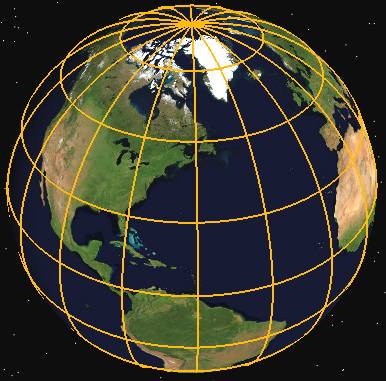|
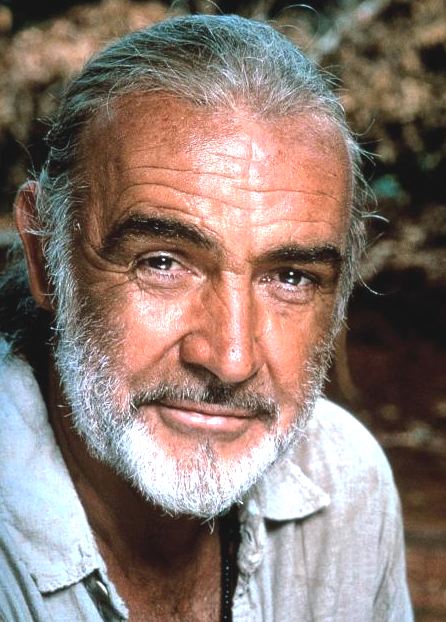
Sean Connery is the Medicine
Man in search of the cure for cancer
Medicine Man is a 1992 American film directed by John McTiernan. The film stars Sean Connery and Lorraine Bracco. It also features a noteworthy score by composer Jerry Goldsmith.
Okay, so that's the nuts and bolts, but the truth is that this is a superb
movie that strikes a chord with all environmentalists. It is one of my all
time favorites. Sean Connery is John
Campbell - brilliant, nicely supported by Lorraine Bracco. I didn't
understand the Razzie bit - oh, a joke!
PLOT
A pharmaceutical company sends biochemist Dr. Rae Crane into the Amazonian rainforest to locate researcher Robert Campbell after his wife and research partner abandon him.
Crane is bringing equipment and supplies, but Campbell is nevertheless upset the research partner is not forthcoming. He tries to send Crane home, but she demurs, as she has been assigned to determine whether Campbell's research deserves continued funding.
Campbell has found a cure for cancer, but attempts to synthesize the compound have failed. With supplies of the successful serum running low, Campbell isolates a derivative of a species of flower from which the formula can be synthesized and with Crane's help is determined to find its source.
A logging company is building a road headed straight for the village, threatening to expose the native population to potentially lethal foreign antigens, as has happened before. In fact, Campbell's wife left him because he could not forgive himself for the tragedy.
A small boy appears with malignant neoplasms and Campell, Crane, the boy, and his father set out in search of Campbell's predecessor, a medicine man from whom Campbell once acquired his knowledge of flowers. Upon encountering Campbell's entourage, the medicine man flees in fear. Though he is reluctant to pursue the man further, Crane convinces him circumstances demand that he must.
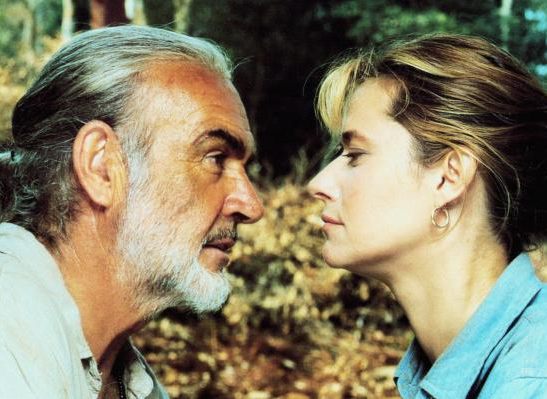
Sean Connery v Lorraine Bracco
Campbell rescues Crane from a fall, then locates the medicine man, whom he is compelled to fight in order to heal the medicine man's wounded pride and gain further necessary information. Unfortunately, the medicine man reveals that the flowers have no "juju"--power to heal. Father and son agree to return another time.
Back at the village, Crane initially refuses to allow Campbell to inoculate the boy with the last of the serum until more can be synthesized. But when the boy's condition worsens, she gives in and the boy is inoculated.
The next morning, the boy is better but the village is in tumult. The logging road is nearly finished. Campbell appeals to the company's workers to halt construction until he can conclude his research, but it refuses.
In desperation and after new samples fail to contain the missing compound, Crane runs the chromatograph one more time and accidentally discovers that the source of the cure is not the flower but a species of rare ant indigenous to the rainforest. Campbell demands the construction stop. A fight results and a bulldozer catches fire, destroying the village and the research station along with many acres of rainforest.
The next day, Crane promises to send Campbell new equipment and the research assistant he'd originally requested. She is about to return home when she meets the medicine man. He symbolically passes on his mantle to Campbell, and Crane accepts an invitation to continue working with him in exchange for recognition for co-discovering the source of the compound.
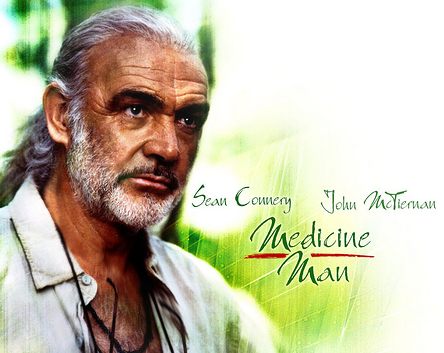
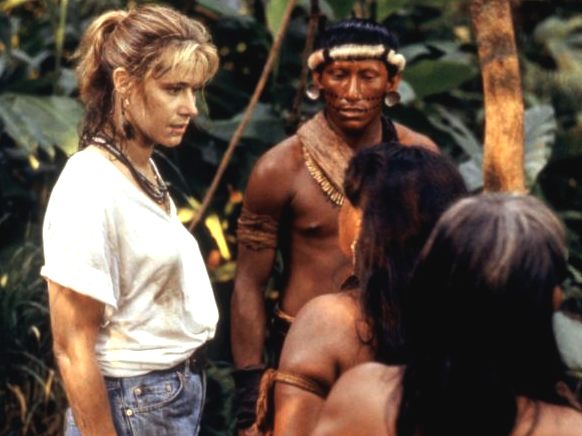
Sean Connery as the Medicine
Man (left) Lorraine Bracco is told a tribe member has cancer, and for
Campbell to cure her.
CAST
Sean Connery as Dr. Robert Campbell
Lorraine Bracco as Dr. Rae Crane
José Wilker as Dr. Miguel Ornega
SOUND TRACK
The music for Medicine Man was composed and conducted by veteran
Jerry Goldsmith. The score, a blend of orchestra, synthetic elements, and guitar solos, was praised by critics and is considered one of the film's few strengths. The soundtrack was released 4 February 1994 through Varèse Sarabande and features fourteen tracks.
Truly, the sound track sums up the mood and sets the mood. Nice one Jerry.
"Rae's Arrival" (5:06)
"First Morning" (3:46)
"Campbell and the Children" (1:57)
"The Trees" (6:01)
"The Harvest" (3:11)
"Mocara" (3:36)
"Mountain High" (2:41)
"Without a Net" (4:19)
"Finger Painting" (2:30)
"What's Wrong" (1:52)
"The Injection" (2:09)
"The Sugar" (2:08)
"The Fire" (2:10)
"A Meal and a Bath" (8:03)
RECEPTION
The movie was panned by critics. Medicine Man maintains a 24% rating on Rotten Tomatoes based on 21 reviews. Lorraine Bracco's performance in the film earned her a Razzie Award nomination for Worst Actress.
BOX OFFICE
The movie debuted at No. 1. The following week it was knocked out of the top spot by Wayne's World. The film eventually grossed $45.5 million domestically, earning back its expenses.
It didn't help that you can't buy the DVD on several countries. What were
they thinking of?
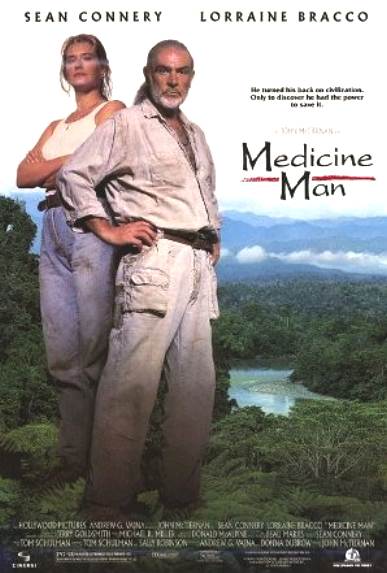
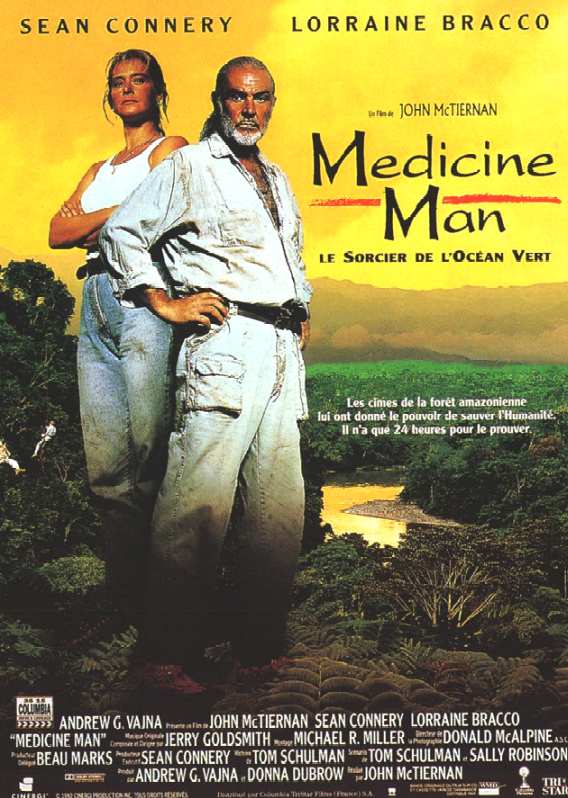
Medicine
Man film posters
REAL
MEDICINE
MEN
"Medicine man" or "medicine woman" are English terms used to describe traditional healers and spiritual leaders among Native American and other indigenous or aboriginal peoples.
Anthropologists tend to prefer the term "shaman," a specific term for a spiritual mediator from the Tungusic peoples of Siberia.
Role in native society
The primary function of these "medicine elders" is to secure the help of the spirit world, including the Great Spirit (Wakan Tanka in the language of the Lakota Sioux), for the benefit of the entire community.
Sometimes the help sought may be for the sake of healing disease, sometimes it may be for the sake of healing the psyche, sometimes the goal is to promote harmony between human groups or between humans & nature. So the term "medicine man/woman" is not entirely inappropriate, but it greatly oversimplifies and also skews the depiction of the people whose role in society complements that of the chief. These people are not the Native American equivalent of the Chinese "barefoot doctors", herbalists, nor of the emergency medical technicians who ride rescue vehicles.
To be recognized as the one who performs this function of bridging between the natural world and the spiritual world for the benefit of the community, an individual must be validated in his role by that community. Medicine men and women study through a medicine society or from a single teacher.
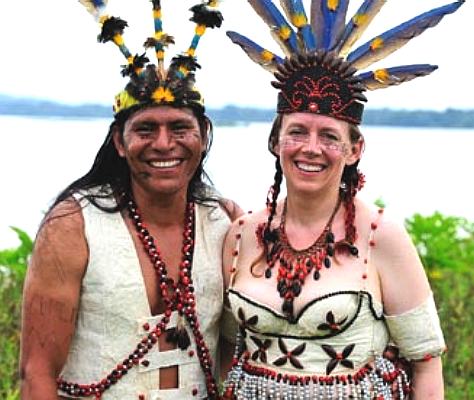
Patricio Jipa (Shaman) and his
wife Mari Muench - A Real life Medicine Man story
Cultural context
The term "medicine people" is commonly used in Native American communities, for example, when Arwen Nuttall (Cherokee) of the National Museum of the American Indian writes, "The knowledge possessed by medicine people is privileged, and it often remains in particular families."
Native Americans tend to be quite reluctant to discuss issues about medicine or medicine people with non-Indians. In some cultures, the people will not even discuss these matters with Indians from other tribes. In most tribes medicine elders are not expected to advertise or introduce themselves as such. As Nuttall writes, "An inquiry to a Native person about religious beliefs or ceremonies is often viewed with suspicion. One example of this was the Apache medicine cord or Izze-kloth, whose purpose and use by Apache medicine elders was a mystery to nineteenth century ethnologists because "the Apache look upon these cords as so sacred that strangers are not allowed to see them, much less handle them or talk about them."
The 1954 version of Webster's New World Dictionary of the American Language, reflects the poorly grounded perceptions of the people whose use of the term effectively defined it for the people of that time: "a man supposed to have supernatural powers of curing disease and controlling spirits." In effect, such definitions were not explanations of what these "medicine people" were to their own communities, but instead reported on the consensus of socially and psychologically remote observers when they tried to categorize these individuals. The term "medicine man/woman," like the term "shaman", has been criticized by Native Americans, as well as other specialists in the fields of religion and anthropology.
The term "medicine man/woman" was also frequently used by Europeans to refer to African traditional healers, also known as "witch doctors" or "fetish men/women".
http://www.youtube.com/watch?v=QfoGdgDSSz4
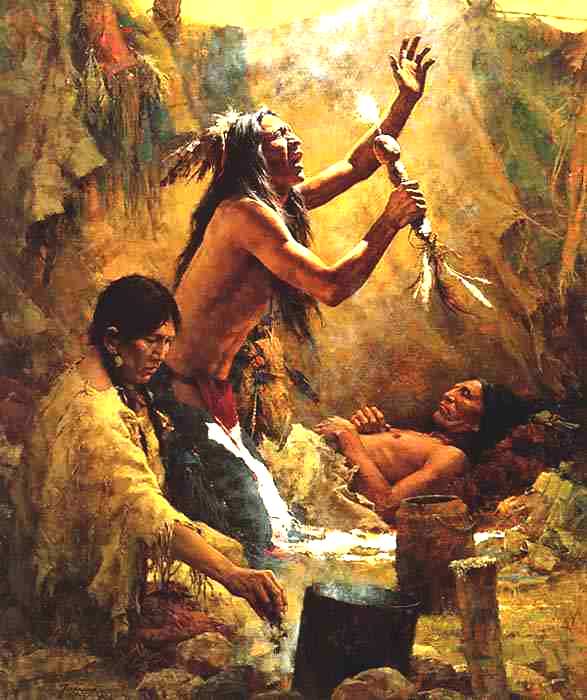
Howard
Terpning oil painting, American Indian medicine man
A
- Z FILMS INDEX
A
- Z ACTORS INDEX
|
